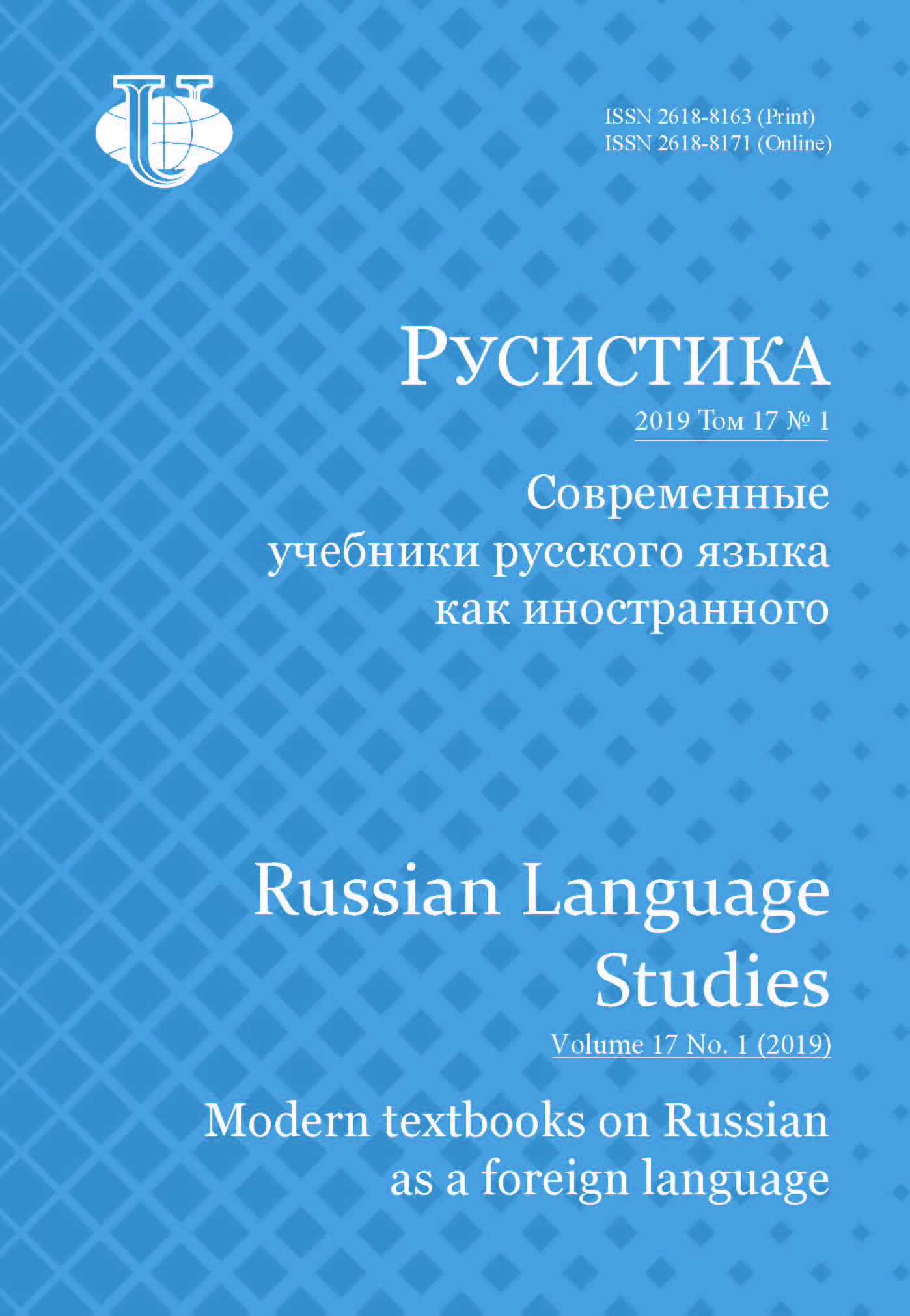Textbooks on Russian as a foreign language: from the experience of work at the preparatory faculty in M.K. Ammosov North-Eastern Federal University
- Authors: Antonova L.N1, Tolstyakova K.P1
-
Affiliations:
- M.K. Ammosov North-Eastern Federal University
- Issue: Vol 17, No 1 (2019): MODERN TEXTBOOKS ON RUSSIAN AS A FOREIGN LANGUAGE
- Pages: 103-114
- Section: Page of a young scientist
- URL: https://journals.rudn.ru/russian-language-studies/article/view/20500
- DOI: https://doi.org/10.22363/2618-8163-2019-17-1-103-114
- ID: 20500
Cite item
Full Text
Abstract
This article deals with the textbooks used in teaching Russian as a foreign language (RFL) at preparatory faculty in M.K. Ammosov North-Eastern Federal University: Esmantova T.L. Russian: 5 elements: A1 level (elementary); Chernyshev S.I. Let’s go! Russian for adults. Elementary course; Evseeva K.S., Dmitrieva E.N., Nikiforova E.P., Samsonova L.N. The Russian language. Oral course for foreign students. Tutorial. The authors use A.A. Akishina, O.E. Kagan’s classification for assessing the textbooks. The classification includes the following parametres: clearly defined goals; a set of training texts, adequacy and effectiveness of the exercises; the number of communication exercises; balance between training and communication exercises; the variety of functions; authentic texts; vocabulary that reflects the communicative needs and interests of students; grammar according to communicative needs; availability of audio and video applications. The analysis shows advantages and disadvantages of the textbooks according to modern requirements to educational activity in a foreign audience. The article reveals the problems arising in direct pupil-teacher interaction during fulfilling the tasks in different organizational forms: at the lessons, at home and in out-of-class events. Special attention is paid to the only textbook on RFL written by the group of teachers of the Yakut State University (1996) which can serve as a basis of a textbook with a national and regional component.
About the authors
Lina N Antonova
M.K. Ammosov North-Eastern Federal University
Author for correspondence.
Email: antonovalinanik@gmail.com
Аssistant Teacher of Russian as a Foreign Language at M.K. Ammosov North-Eastern Federal University
58 Belinsky St., Yakutsk, Republic of Sakha (Yakutia), 677027, Russian FederationKristina P Tolstyakova
M.K. Ammosov North-Eastern Federal University
Email: kristina.tolstyakova@mail.ru
Assistant Teacher of Russian as a Foreign Language at M.K. Ammosov North-Eastern Federal University
58 Belinsky St., Yakutsk, Republic of Sakha (Yakutia), 677027, Russian FederationReferences
- Akishina, A.A., & Kagan, O.E. (2016). Uchimsya uchit’: dlya prepodavatelya russkogo yazyka kak inostrannogo [Learning to teach: for the teachers of Russian as a foreign language]. Moscow: Russkii yazyk Publ. (In Russ.)
- Azimov, E.G., & Shchukin, A.N. (2009). Novyi slovar’ metodicheskikh terminov i ponyatii [The New Dictionary of Methodical Terms]. Moscow: IKAR Publ. (In Russ.)
- Chernyshev, S.I. (2009). Poekhali! Russkii yazyk dlya vzroslykh. Nachal’nyi kurs [Let’s go! Russian for adults. Beginner course]. Saint Petersburg: Zlatoust Publ. (In Russ.)
- Esmantova, T.L. (2013). Russkii yazyk: 5 ehlementov: uroven’ A1 [Russian language: 5 elements]. Saint Petersburg: Zlatoust Publ. (In Russ.)
- Evseeva, K.S., Dmitrieva, E.N., Nikiforova, E.P., & Samsonova, L.N. (1996). Russkii yazyk. Ustnyi kurs dlya studentov-inostrantsev: uchebnoe posobie [Russian language. Oral course for foreigners: manual]. Yakutsk: NIPK “Sakhapoligrafizdat” Publ. (In Russ.)
- Goryanskii, V.D. (1979). Voprosy mestnogo stranovedeniya kak sostavnaya chast’ lingvostranovedcheskogo aspekta prepodavaniya [Questions of local countrystudying as a part of linguistic and cultural studying aspect]. Linguistic cultural studies in teaching Russian as a foreign language. Moscow.Russkii yazyk Publ. (In Russ.)
- Kryuchkova, L.S., & Moshchinskaya, N.V. (2012). Russkii yazyk kak inostrannyi. Prakticheskaya metodika obucheniya russkomu yazyku kak inostrannomu [Russian as a foreign language. Practical methods of teaching Russian as a foreign language]. Moscow: Flinta, Nauka Publ. (In Russ.)
- Moskovkin, L.V., & Shchukin, A.N. (2014). Khrestomatiya po metodike prepodavaniya russkogo yazyka kak inostrannogo [Anthology on methods of teaching Russian as a foreign language]. Moscow: Russkii yazyk. Kursy Publ. (In Russ.)
- Shchukin, A.N. (2008). Lingvodidakticheskii entsiklopedicheskii slovar’ [Linguodidactic encyclopedic dictionary]. Moscow: Astrel’, AST, Khranitel’ Publ. (In Russ.)
- Strelchuk, E.N. (2009) Formirovaniye rechevoy kul’tury inostrannykh uchashchikhsya s uchetom regional’nogo komponenta [Foregn students’ speech culture formation considering regional component]. Vestnik RUDN. Seriya: Voprosy obrazovaniya: yazyki i spetsial’nost’ [RUDN Journal. Series: Educational Issues: Languages and Specialties], (3), 69—74. (In Russ.)
- Strelchuk, E.N., & Lonskaya A.Y. (2018). Formation and Transformation of the Concept “Russia” in the Picture of the World of Modern American Students. Theoretical and Practical Issues of Journalism, 7(4), 741—754. doi: 10.17150/2308-6203.2018.7(4).741-754 (In Russ.)
- Tomashuk, N.V. (2016). Rol’ autentichnykh materialov v obuchenii inostrannomu yazyku [The role of authenthic materials in teaching a foreign languages]. Evraziiskii nauchnyi zhurnal [Eurasian scientific journal], (10), 40—41. (In Russ.)
Supplementary files














